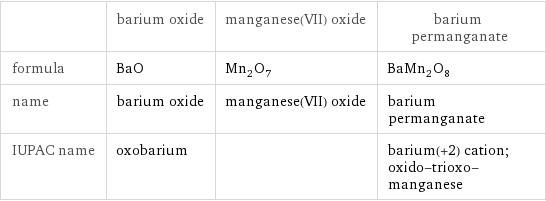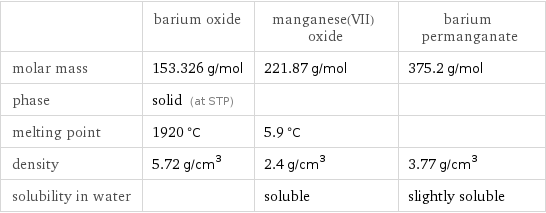Input interpretation

BaO barium oxide + Mn_2O_7 manganese(VII) oxide ⟶ BaMn_2O_8 barium permanganate
Balanced equation

Balance the chemical equation algebraically: BaO + Mn_2O_7 ⟶ BaMn_2O_8 Add stoichiometric coefficients, c_i, to the reactants and products: c_1 BaO + c_2 Mn_2O_7 ⟶ c_3 BaMn_2O_8 Set the number of atoms in the reactants equal to the number of atoms in the products for Ba, O and Mn: Ba: | c_1 = c_3 O: | c_1 + 7 c_2 = 8 c_3 Mn: | 2 c_2 = 2 c_3 Since the coefficients are relative quantities and underdetermined, choose a coefficient to set arbitrarily. To keep the coefficients small, the arbitrary value is ordinarily one. For instance, set c_1 = 1 and solve the system of equations for the remaining coefficients: c_1 = 1 c_2 = 1 c_3 = 1 Substitute the coefficients into the chemical reaction to obtain the balanced equation: Answer: | | BaO + Mn_2O_7 ⟶ BaMn_2O_8
Structures

+ ⟶
Names

barium oxide + manganese(VII) oxide ⟶ barium permanganate
Equilibrium constant
![Construct the equilibrium constant, K, expression for: BaO + Mn_2O_7 ⟶ BaMn_2O_8 Plan: • Balance the chemical equation. • Determine the stoichiometric numbers. • Assemble the activity expression for each chemical species. • Use the activity expressions to build the equilibrium constant expression. Write the balanced chemical equation: BaO + Mn_2O_7 ⟶ BaMn_2O_8 Assign stoichiometric numbers, ν_i, using the stoichiometric coefficients, c_i, from the balanced chemical equation in the following manner: ν_i = -c_i for reactants and ν_i = c_i for products: chemical species | c_i | ν_i BaO | 1 | -1 Mn_2O_7 | 1 | -1 BaMn_2O_8 | 1 | 1 Assemble the activity expressions accounting for the state of matter and ν_i: chemical species | c_i | ν_i | activity expression BaO | 1 | -1 | ([BaO])^(-1) Mn_2O_7 | 1 | -1 | ([Mn2O7])^(-1) BaMn_2O_8 | 1 | 1 | [BaMn2O8] The equilibrium constant symbol in the concentration basis is: K_c Mulitply the activity expressions to arrive at the K_c expression: Answer: | | K_c = ([BaO])^(-1) ([Mn2O7])^(-1) [BaMn2O8] = ([BaMn2O8])/([BaO] [Mn2O7])](../image_source/24d4504d2c454d03812be605eb7de702.png)
Construct the equilibrium constant, K, expression for: BaO + Mn_2O_7 ⟶ BaMn_2O_8 Plan: • Balance the chemical equation. • Determine the stoichiometric numbers. • Assemble the activity expression for each chemical species. • Use the activity expressions to build the equilibrium constant expression. Write the balanced chemical equation: BaO + Mn_2O_7 ⟶ BaMn_2O_8 Assign stoichiometric numbers, ν_i, using the stoichiometric coefficients, c_i, from the balanced chemical equation in the following manner: ν_i = -c_i for reactants and ν_i = c_i for products: chemical species | c_i | ν_i BaO | 1 | -1 Mn_2O_7 | 1 | -1 BaMn_2O_8 | 1 | 1 Assemble the activity expressions accounting for the state of matter and ν_i: chemical species | c_i | ν_i | activity expression BaO | 1 | -1 | ([BaO])^(-1) Mn_2O_7 | 1 | -1 | ([Mn2O7])^(-1) BaMn_2O_8 | 1 | 1 | [BaMn2O8] The equilibrium constant symbol in the concentration basis is: K_c Mulitply the activity expressions to arrive at the K_c expression: Answer: | | K_c = ([BaO])^(-1) ([Mn2O7])^(-1) [BaMn2O8] = ([BaMn2O8])/([BaO] [Mn2O7])
Rate of reaction
![Construct the rate of reaction expression for: BaO + Mn_2O_7 ⟶ BaMn_2O_8 Plan: • Balance the chemical equation. • Determine the stoichiometric numbers. • Assemble the rate term for each chemical species. • Write the rate of reaction expression. Write the balanced chemical equation: BaO + Mn_2O_7 ⟶ BaMn_2O_8 Assign stoichiometric numbers, ν_i, using the stoichiometric coefficients, c_i, from the balanced chemical equation in the following manner: ν_i = -c_i for reactants and ν_i = c_i for products: chemical species | c_i | ν_i BaO | 1 | -1 Mn_2O_7 | 1 | -1 BaMn_2O_8 | 1 | 1 The rate term for each chemical species, B_i, is 1/ν_i(Δ[B_i])/(Δt) where [B_i] is the amount concentration and t is time: chemical species | c_i | ν_i | rate term BaO | 1 | -1 | -(Δ[BaO])/(Δt) Mn_2O_7 | 1 | -1 | -(Δ[Mn2O7])/(Δt) BaMn_2O_8 | 1 | 1 | (Δ[BaMn2O8])/(Δt) (for infinitesimal rate of change, replace Δ with d) Set the rate terms equal to each other to arrive at the rate expression: Answer: | | rate = -(Δ[BaO])/(Δt) = -(Δ[Mn2O7])/(Δt) = (Δ[BaMn2O8])/(Δt) (assuming constant volume and no accumulation of intermediates or side products)](../image_source/8db761830bd76377db73954fee54d6ef.png)
Construct the rate of reaction expression for: BaO + Mn_2O_7 ⟶ BaMn_2O_8 Plan: • Balance the chemical equation. • Determine the stoichiometric numbers. • Assemble the rate term for each chemical species. • Write the rate of reaction expression. Write the balanced chemical equation: BaO + Mn_2O_7 ⟶ BaMn_2O_8 Assign stoichiometric numbers, ν_i, using the stoichiometric coefficients, c_i, from the balanced chemical equation in the following manner: ν_i = -c_i for reactants and ν_i = c_i for products: chemical species | c_i | ν_i BaO | 1 | -1 Mn_2O_7 | 1 | -1 BaMn_2O_8 | 1 | 1 The rate term for each chemical species, B_i, is 1/ν_i(Δ[B_i])/(Δt) where [B_i] is the amount concentration and t is time: chemical species | c_i | ν_i | rate term BaO | 1 | -1 | -(Δ[BaO])/(Δt) Mn_2O_7 | 1 | -1 | -(Δ[Mn2O7])/(Δt) BaMn_2O_8 | 1 | 1 | (Δ[BaMn2O8])/(Δt) (for infinitesimal rate of change, replace Δ with d) Set the rate terms equal to each other to arrive at the rate expression: Answer: | | rate = -(Δ[BaO])/(Δt) = -(Δ[Mn2O7])/(Δt) = (Δ[BaMn2O8])/(Δt) (assuming constant volume and no accumulation of intermediates or side products)
Chemical names and formulas

| barium oxide | manganese(VII) oxide | barium permanganate formula | BaO | Mn_2O_7 | BaMn_2O_8 name | barium oxide | manganese(VII) oxide | barium permanganate IUPAC name | oxobarium | | barium(+2) cation; oxido-trioxo-manganese
Substance properties

| barium oxide | manganese(VII) oxide | barium permanganate molar mass | 153.326 g/mol | 221.87 g/mol | 375.2 g/mol phase | solid (at STP) | | melting point | 1920 °C | 5.9 °C | density | 5.72 g/cm^3 | 2.4 g/cm^3 | 3.77 g/cm^3 solubility in water | | soluble | slightly soluble
Units
